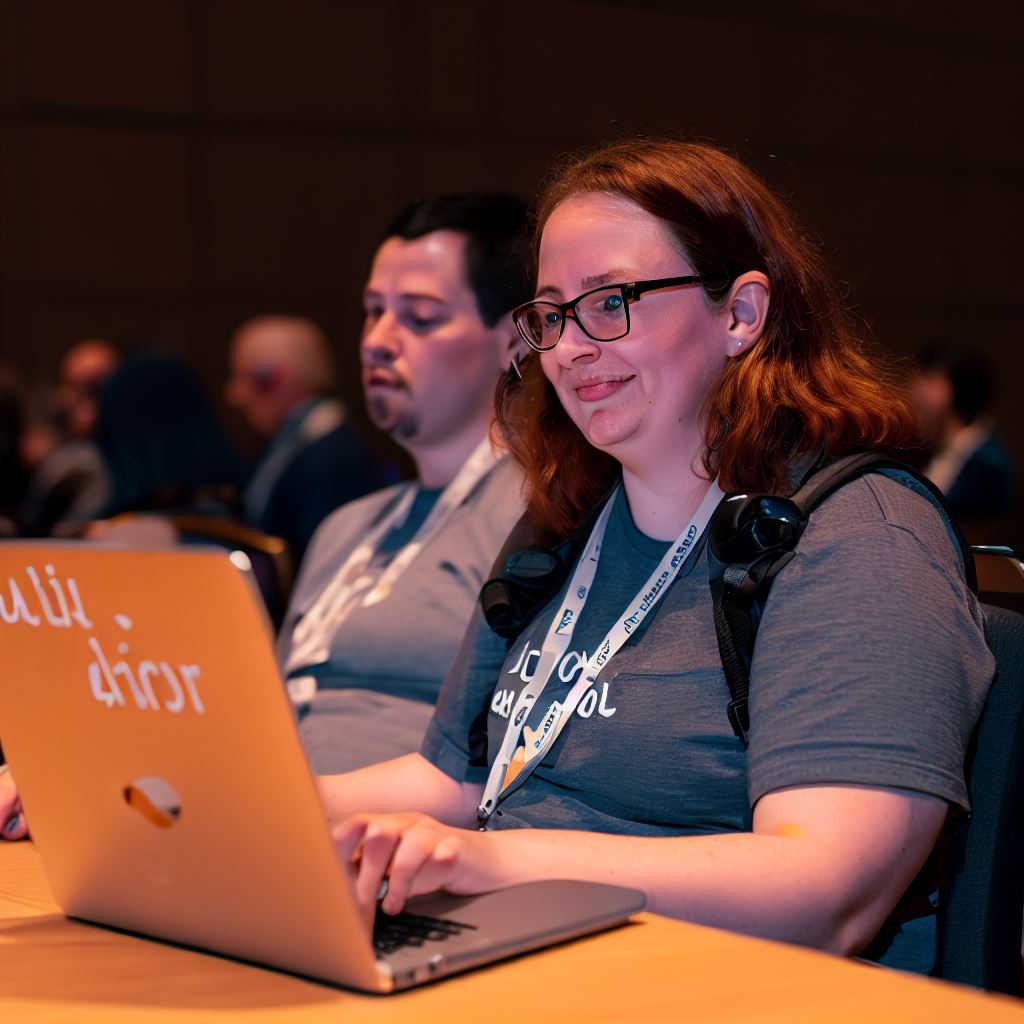Introduction
Accessibility is a fundamental aspect of coding organizations that cannot be overlooked.
It plays a crucial role in ensuring that all individuals, regardless of their abilities or backgrounds, have equal opportunities and can participate fully in the world of technology.
This blog post delves into the importance of accessibility within coding organizations and how it contributes to a more inclusive and equitable tech industry.
We will discuss various aspects of accessibility, from creating user-friendly software interfaces to providing coding education that accommodates diverse learning styles and needs.
Additionally, we will explore the impact of accessibility on marginalized communities, economic mobility, and the overall innovation landscape within the tech industry.
By the end of this blog post, you will have a comprehensive understanding of why accessibility is a cornerstone of coding organizations and how it benefits both individuals and the broader tech community.
Understanding Accessibility
Definition and significance of accessibility in coding:
- Accessibility in coding refers to creating software and websites that can be used by people with disabilities.
- It is significant as it ensures equal access, participation, and opportunities for all users.
Examples of accessibility barriers and challenges:
- Lack of alternative text for images, making it impossible for visually impaired users to understand content.
- Complex navigation structures that confuse users with cognitive disabilities.
- Color choices that make it difficult for colorblind users to distinguish between elements.
The importance of inclusive tools and technologies
Inclusive tools in coding organizations are paramount for accessibility, promoting equal engagement for individuals with disabilities.
These technologies encourage diversity and collaboration within coding communities.
Accessibility in coding creates a level playing field for everyone and removes barriers for those with disabilities.
Understanding accessibility’s definition and significance is essential for coding organizations to foster inclusivity effectively.
It involves developing software, apps, and websites accessible to individuals with disabilities.
Accessibility in coding is pivotal for an inclusive digital world, ensuring equal opportunities and participation for all users.
Coding organizations should recognize the barriers and challenges faced by individuals with disabilities when accessing digital content.
Issues like missing alternative text, complex navigation, and insufficient color contrast need to be addressed.
To overcome these challenges, coding organizations must prioritize the development and adoption of inclusive tools and technologies.
Tech Consulting Tailored to Your Coding Journey
Get expert guidance in coding with a personalized consultation. Receive unique, actionable insights delivered in 1-3 business days.
Get StartedThese tools, including screen readers, voice control, and keyboard shortcuts, empower individuals with disabilities to engage effectively in coding activities.
Inclusive technologies not only enhance accessibility but also boost collaboration and diversity within coding organizations.
When coding tools accommodate diverse needs, individuals with disabilities can contribute unique perspectives and skills to projects.
This diversity drives innovation and ensures solutions cater to a broad range of users.
Therefore, grasping the essence of accessibility in coding is essential for creating an inclusive digital environment.
Coding organizations must acknowledge accessibility’s definition, significance, and the barriers faced by those with disabilities.
By emphasizing inclusive tools, organizations ensure their products and services are accessible to everyone, unlocking a wider talent pool and promoting innovation.
Read: How Coding Organizations Support Marginalized Communities in Tech
Legal and Ethical Considerations
Overview of laws and regulations related to accessibility (e.g., ADA, WCAG)
- The Americans with Disabilities Act (ADA) ensures equal rights and opportunities for people with disabilities.
- The Web Content Accessibility Guidelines (WCAG) provide standards for creating accessible web content.
- Other regulations, such as Section 508, also impose accessibility requirements for federal agencies and organizations receiving federal funding.
Discussion on the ethical obligation of coding organizations to prioritize accessibility
- Coding organizations have a moral responsibility to make their tools and products accessible to everyone.
- Accessibility promotes inclusivity and ensures that individuals with disabilities can participate fully in society.
- By prioritizing accessibility, coding organizations demonstrate their commitment to diversity and equal opportunities.
Consequences of non-compliance with accessibility guidelines
Non-compliance with accessibility guidelines can have severe legal consequences, including lawsuits and financial penalties.
It can also result in reputational damage and a loss of trust among users.
Inaccessibility limits market reach and hampers business opportunities.
However, legal compliance is not the sole reason to prioritize accessibility; ethical obligations are equally important.
Understanding the legal and ethical aspects of accessibility is crucial for coding organizations.
Compliance with laws like the ADA and WCAG ensures equal access to digital tools.
Build Your Vision, Perfectly Tailored
Get a custom-built website or application that matches your vision and needs. Stand out from the crowd with a solution designed just for you—professional, scalable, and seamless.
Get StartedThese regulations guarantee that individuals with disabilities can effectively navigate and use websites and applications.
Coding organizations should prioritize accessibility to build an inclusive society.
Accessible tools demonstrate a commitment to diversity and equal opportunities.
Failure to prioritize accessibility can lead to lawsuits, financial penalties, and reputational damage for coding organizations.
Non-compliance affects both finances and trust among users, particularly those with disabilities.
Inaccessible tools limit market reach, missing out on potential users.
Embracing accessibility offers expanded market opportunities and enhances user satisfaction.
Coding organizations must consider the legal and ethical implications of their accessibility practices.
Compliance ensures inclusivity and avoids legal consequences.
Prioritizing accessibility aligns with ethical obligations and promotes diversity and equal opportunities.
By doing so, coding organizations create inclusive tools that benefit everyone, regardless of their abilities.
Read: Coding Dojo Alumni: Tech Leaders Share Their Stories
Key Principles for Building Inclusive Tools
Universal Design: Creating products usable by individuals with various abilities
Universal design is an essential principle in creating inclusive tools and coding organizations.
It focuses on designing products that can be used by individuals with a wide range of abilities and disabilities.
Optimize Your Profile, Get Noticed
Make your resume and LinkedIn stand out to employers with a profile that highlights your technical skills and project experience. Elevate your career with a polished and professional presence.
Get NoticedTo achieve universal design, coding organizations should consider implementing features and functionalities that are accessible to everyone.
This includes providing alternative text for images, using color contrasts that are readable by individuals with visual impairments, and ensuring keyboard navigation for those who cannot use a mouse.
By following the principles of universal design, coding organizations can ensure that their tools can be effectively used by individuals with disabilities, thus promoting inclusivity in the coding community.
User-Centered Design: Putting the needs and experiences of diverse users first
User-centered design is a key principle that ensures the needs and experiences of diverse users are prioritized in the development of inclusive tools.
To implement user-centered design, coding organizations should conduct user research and involve individuals with different abilities in the design process.
This can include usability testing with individuals who have disabilities, gathering feedback from users with diverse backgrounds, and incorporating their insights into the development process.
By putting the needs and experiences of diverse users first, coding organizations can create tools that cater to a broader audience, promoting inclusivity and ensuring that no user is left behind.
Clear and Consistent Design: Ensuring clarity and consistency in user interfaces
Clear and consistent design is another crucial principle for building inclusive tools.
It ensures that users can easily navigate and understand the functionalities of a tool, regardless of their abilities or disabilities.
Coding organizations should focus on providing clear instructions, using intuitive icons, and organizing content in a logical and consistent manner.
This can help individuals with cognitive or visual impairments better understand and interact with the tool.
By ensuring clarity and consistency in user interfaces, coding organizations can create inclusive tools that are easy to use for all users, regardless of their abilities or disabilities.
In essence, building inclusive tools requires adhering to key principles such as universal design, user-centered design, and clear and consistent design.
By implementing these principles, coding organizations can create products that are accessible, prioritize the needs of diverse users, and provide clear and intuitive user interfaces.
By embracing inclusivity in coding organizations, we can create a more diverse and accessible coding community for everyone.
Read: The Future of Tech: Coding Dojo’s Role in Shaping Careers
Common Accessibility Techniques and Tools
Web Accessibility: Techniques for improving accessibility in web development
Web accessibility is crucial for ensuring that people with disabilities can fully access and interact with websites.
Here are some techniques to improve web accessibility:
- Use proper headings and semantic HTML to provide a clear structure to your website.
- Add alternative text to images, allowing screen readers to describe them to visually impaired users.
- Ensure sufficient color contrast between text and background to make it readable for people with visual impairments.
- Provide transcripts or captions for multimedia content like videos or audio files.
- Make your website keyboard accessible, allowing users to navigate and interact with it using only the keyboard.
- Use descriptive link text instead of generic phrases like “click here.”
- Test your website with different assistive technologies to ensure compatibility and optimal usability.
Assistive Technologies: Overview of tools for individuals with disabilities
Assistive technologies are tools and software designed to help individuals with disabilities navigate and interact with digital content.
Here are some commonly used assistive technologies:
- Screen readers: Software that reads text on the screen aloud for visually impaired users.
- Screen magnifiers: Tools that enlarge content on the screen for people with low vision.
- Braille displays: Devices that convert digital text into Braille for individuals who are blind.
- Speech recognition software: Tools that convert spoken words into written text, aiding users with mobility or dexterity impairments.
- Alternative input devices: Keyboards, trackballs, or switches designed for users with limited mobility.
- Text-to-speech software: Applications that convert written text into spoken words, assisting individuals with reading difficulties.
- Eye-tracking technology: Devices that track eye movements to allow control of a computer interface.
Automated Testing: Utilizing software tools to assess accessibility compliance
Automated testing tools can help identify accessibility issues in websites or applications.
Here are some popular automated testing tools:
- WAVE: a web accessibility evaluation tool that analyzes web pages for compliance with accessibility guidelines.
- axe: an open-source accessibility testing engine that provides automated testing and reporting.
- Lighthouse: a tool built into Google Chrome’s developer tools that checks a website’s performance, accessibility, and other aspects.
- Accessibility Insights: a suite of tools and guidelines provided by Microsoft to test and improve website accessibility.
- Tota11y: an accessibility visualization toolkit that helps developers identify and fix accessibility issues in their code.
- Tenon.io: a web accessibility API that developers can integrate into their testing and development processes.
- Pa11y: an automated accessibility testing tool that scans web pages for potential issues and provides detailed reports.
By incorporating web accessibility techniques, understanding assistive technologies, and utilizing automated testing tools, organizations can ensure that their coding practices and digital products are accessible to all users.
Read: Balancing Life & Study: Tips for Coding Dojo Attendees

Implementing Accessibility in Coding Organizations
Training and Education: Educating developers and staff on accessibility practices
Educating developers and staff on the importance of accessibility in coding organizations is crucial for creating inclusive tools.
By providing comprehensive training, developers can learn about the challenges faced by people with disabilities.
They can also understand the best practices and techniques for incorporating accessibility into their coding projects.
Development Guidelines: Establishing accessibility guidelines for coding projects
Creating specific accessibility guidelines helps to ensure that coding projects are developed with inclusivity in mind.
These guidelines should cover areas such as keyboard navigation, screen reader compatibility, and color contrast.
By following these guidelines, developers can create applications that are accessible to users of all abilities.
Collaboration and Feedback: Engaging users with disabilities for feedback and improvement
Engaging users with disabilities in the development process is essential for creating truly inclusive tools.
By seeking their feedback and involving them in testing, developers can address any accessibility issues and make necessary improvements.
This collaboration ensures that the tools are designed to meet the needs of people with disabilities.
Learn More: Rust for System Programming: Sample Code Snippets
Case Studies and Best Practices
Highlighting successful examples of coding organizations prioritizing accessibility
- GitHub Coding Org: Implemented accessible coding practices, resulting in increased participation from diverse developers.
- Coursera Code Co.: Developed an inclusive coding platform that accommodates various disabilities, fostering equal opportunities.
- Codecademy Coding For All: Established a mentorship program for disabled programmers, promoting inclusivity within the coding community.
Best practices for promoting and implementing accessibility
- Conduct thorough accessibility audits to identify areas for improvement and prioritize accessibility features.
- Train developers and designers on inclusive coding and design principles to ensure accessibility from the start.
- Involve disabled individuals in the design and testing process to gain valuable insights and improve accessibility.
Learning from past challenges and failures in accessibility initiatives
- Apache Software Foundation Code Corp: Failed to consider accessibility during development, leading to legal consequences and reputational damage.
- Mozilla Coding Inc.: Struggled with implementing accessible features due to limited awareness and cultural barriers within the organization.
- Linux Foundation Tech: Faced backlash for neglecting accessibility, but successfully recovered by acknowledging mistakes and prioritizing accessibility in future projects.
By highlighting successful examples, coding organizations can learn from their approaches and replicate their inclusive practices.
Implementing best practices, such as conducting audits and involving disabled individuals, can drive accessibility efforts.
Additionally, acknowledging and learning from past challenges and failures will help avoid repeating those mistakes in future accessibility initiatives.
Creating an inclusive and accessible coding environment not only empowers disabled individuals but also enhances overall creativity and innovation within the coding community.
Discover More: Top Websites to Find Daily Coding Challenges
Future of Accessibility in Coding Organizations
Emerging technologies and trends in accessibility
- Advancements in voice recognition technology will enhance accessibility for individuals with limited mobility.
- Improved screen readers and captioning techniques will make digital content more accessible for the visually impaired.
- Gesture-based interfaces and touchless controls will provide new ways for individuals with physical disabilities to interact with technology.
- Artificial intelligence and machine learning will play a crucial role in automating accessibility testing and remediation.
Potential challenges and opportunities in the field
- Keeping up with the fast pace of technological advancements poses a challenge for coding organizations.
- Ensuring that emerging technologies are designed with accessibility in mind from the outset is crucial.
- Collaboration between developers, testers, and users with disabilities is essential for addressing accessibility challenges.
- Opportunities lie in creating innovative solutions that benefit not only individuals with disabilities but society as a whole.
Encouraging a continuous improvement mindset towards accessibility
- Embedding accessibility into the organizational culture by providing training and resources to all employees.
- Establishing accessibility-focused teams or roles to ensure that accessibility is considered throughout the software development life cycle.
- Regularly conducting accessibility audits and seeking feedback from users with disabilities to identify areas for improvement.
- Engaging with the accessibility community and participating in initiatives to promote accessibility education and awareness.
By integrating emerging technologies, addressing potential challenges, and fostering a continuous improvement mindset towards accessibility, coding organizations can ensure that their tools are inclusive for all users.
Discover More: How to Choose the Right Programming Language to Learn
Conclusion
Accessibility is not merely a feature; it’s an ethical imperative for coding organizations.
The significance of making technology inclusive for all cannot be overstated.
As we’ve explored in this section:
Accessibility ensures equal opportunities for everyone, fostering innovation and diversity within the tech industry.
It’s crucial to prioritize accessibility in your coding projects, educational materials, and workplace practices.
Remember that building inclusive tools is not just a responsibility; it’s an opportunity to empower and uplift individuals who may have been marginalized or overlooked.
In your journey as a coder, advocate for accessibility, challenge the status quo, and actively work towards making technology a more welcoming space for all.
By doing so, you contribute to a future where everyone, regardless of their abilities, can fully engage with and benefit from the ever-evolving world of technology.
Take action today, and let accessibility be your guiding principle in shaping a more inclusive tech landscape.




